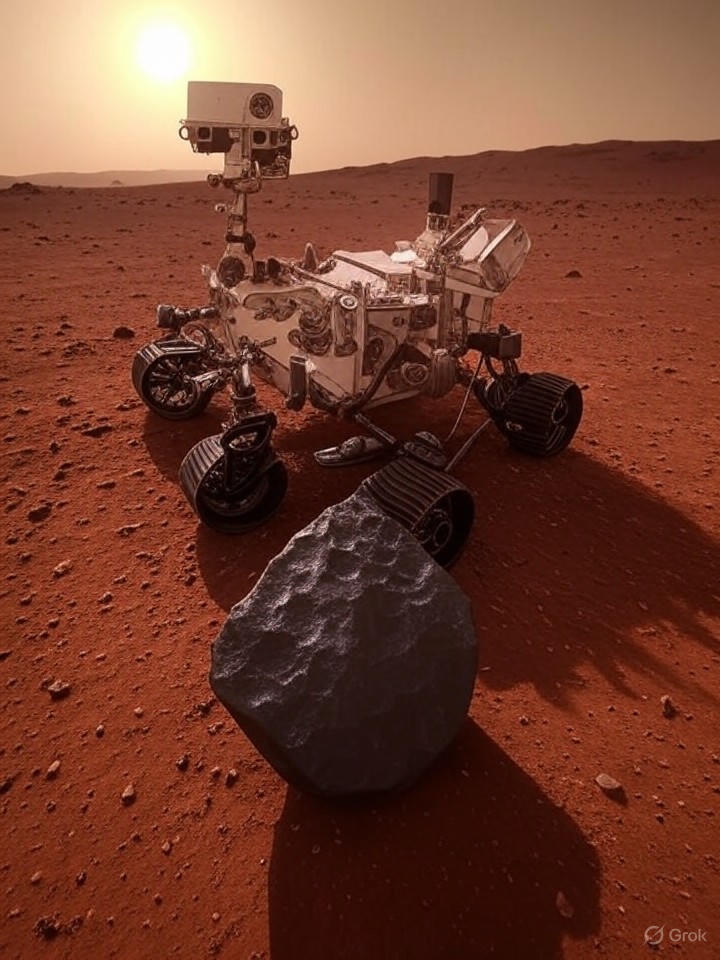Science
NASA’s Perseverance Rover Discovers Intriguing Meteorite on Mars

In a significant discovery on Mars, NASA’s Perseverance rover has uncovered a peculiar metallic rock within Jezero Crater. This fist-sized specimen, named ‘Bunsen Peak’, has been identified as an iron-nickel meteorite, suggesting it originated from the asteroid belt or beyond rather than forming on the Red Planet. The rover’s instruments detected this unusual find during routine scans in September 2025, revealing insights into Mars’ dynamic history as a target for extraterrestrial impacts.
The discovery was highlighted in a recent briefing by mission scientist Dr. Ken Farley, who stated, “This is not something formed on Mars.” This striking find aligns with Perseverance’s ongoing mission to explore the planet’s geological past and its potential to host ancient life. Since landing on Mars in February 2021, the rover has been examining Jezero Crater, which is believed to be an ancient lakebed, for over four years.
Equipped with sophisticated tools, including the SHERLOC instrument and an array of cameras, Perseverance has collected numerous samples, some of which may contain biosignatures. The significance of the meteorite is heightened by the possibility that such objects could have delivered organic compounds to Mars billions of years ago, possibly initiating microbial life.
A Cosmic Visitor’s Journey
NASA announced on September 10, 2025, that Perseverance had also collected a sample from an ancient dry riverbed, which could preserve evidence of microbial life. According to a report from NASA, this sample exhibits unusual mudstones linked with ancient microbial activity. The proximity of these findings suggests an intriguing connection between extraterrestrial impacts and the building blocks of life.
The meteorite’s composition, rich in iron and nickel, closely resembles those found on Earth from the asteroid belt situated between Mars and Jupiter. Dr. Abigail Allwood, a planetary geologist, expressed excitement about the discovery during an interview, emphasizing the potential for these samples to revolutionize our understanding of life on Mars. Future analysis of such samples on Earth, particularly through the planned Mars Sample Return mission, will be crucial for confirming these preliminary findings.
Linking Impacts to Ancient Life
Public interest in Mars exploration has surged, spurred by speculation about unusual formations near the rover. Some social media posts have suggested the presence of unidentified objects, including what appeared to be a “crashed flying saucer.” NASA has dismissed these claims as natural formations or debris, yet they continue to captivate the public’s imagination.
In addition to the meteorite, other intriguing findings include a rock designated as ‘St. Pauls Bay’, which has puzzled geologists with its unique characteristics. The discoveries from Perseverance are reshaping perceptions of Mars’ habitability. Recent findings, including the detection of organic molecules in mudstone, suggest a history of microbial activity similar to that identified by the Curiosity rover earlier in March 2025.
Perseverance’s advanced instruments have played a vital role in these discoveries. The rover’s PIXL tool confirmed the meteorite’s extraterrestrial origins by analyzing its elemental makeup in real-time. This capability, combined with artificial intelligence-driven navigation, enhances the rover’s efficiency in exploring the Martian surface.
As the mission progresses, the implications of these discoveries extend beyond scientific interest. The evidence of multiple water flows in Jezero Crater bolsters the theory of life-supporting conditions on Mars, further emphasized by Perseverance’s time-lapse capture of a comet transit on October 2, 2025.
The potential for future missions is substantial. With the planned Mars Sample Return, a collaboration between NASA and the European Space Agency, scientists hope to analyze these significant findings in detail. Although budgetary constraints pose challenges, the potential for confirming traces of extraterrestrial life keeps the scientific community engaged.
While discussions surrounding these discoveries often lead to speculation, experts emphasize the need for caution. “These are not conclusive proofs, but compelling clues,” stated Dr. Katie Stack Morgan, underscoring the importance of rigorous scientific analysis.
The excitement surrounding these findings has also spurred interest in the private sector, with companies like SpaceX eyeing Mars colonization. Understanding meteorite impacts may inform future habitat designs that protect against cosmic radiation.
As Perseverance continues its exploration, each discovery peels back the layers of Mars’ enigmatic history. The meteorite, alongside biosignature rocks, paints a picture of a world that may have once been habitable and bombarded by space debris. NASA’s Artemis program and potential human missions promise to build upon these robotic insights, transforming our understanding of the cosmos.
-

 Top Stories1 month ago
Top Stories1 month agoNew ‘Star Trek: Voyager’ Game Demo Released, Players Test Limits
-

 World1 month ago
World1 month agoGlobal Air Forces Ranked by Annual Defense Budgets in 2025
-

 World1 month ago
World1 month agoMass Production of F-35 Fighter Jet Drives Down Costs
-

 World1 month ago
World1 month agoElectrification Challenges Demand Advanced Multiphysics Modeling
-

 Science1 month ago
Science1 month agoTime Crystals Revolutionize Quantum Computing Potential
-

 Business1 month ago
Business1 month agoGold Investment Surge: Top Mutual Funds and ETF Alternatives
-

 Entertainment1 month ago
Entertainment1 month agoFreeport Art Gallery Transforms Waste into Creative Masterpieces
-

 Top Stories1 month ago
Top Stories1 month agoDirecTV to Launch AI-Driven Ads with User Likenesses in 2026
-

 Lifestyle1 month ago
Lifestyle1 month agoDiscover Reese Witherspoon’s Chic Dining Room Style for Under $25
-

 Health1 month ago
Health1 month agoGavin Newsom Critiques Trump’s Health and National Guard Plans
-

 Lifestyle1 month ago
Lifestyle1 month agoLia Thomas Honored with ‘Voice of Inspiration’ Award at Dodgers Event
-

 Business1 month ago
Business1 month agoUS Government Denies Coal Lease Bid, Impacting Industry Revival Efforts









